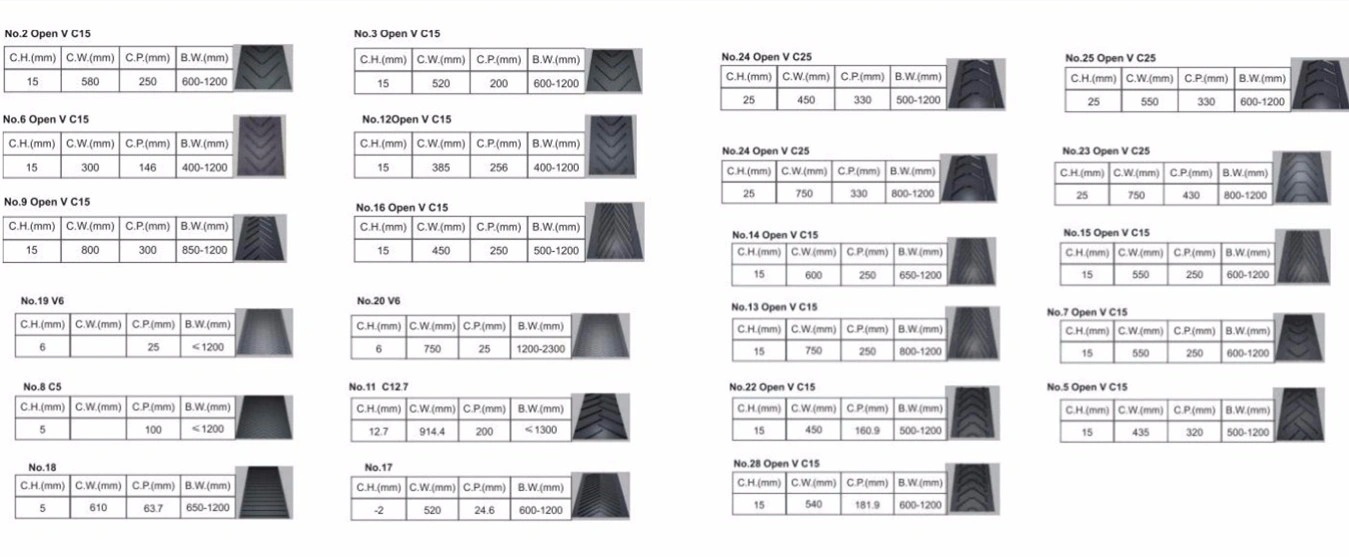Chevron Cleated Belt (Bottom Fiber)

Our Chevron Cleated Belt (Bottom Fiber) are specifically designed for conveying materials effectively at inclines greater than 18o angle. Unlike regular smooth surface pattern conveyors, our Chevron Belts are resistant to slippage, making them vital in the material handling industry. They provide a suitable solution to convey numerous materials between 18⁰ to 45⁰ inclinations.
Pattern Type:
We take pride in introducing high-performance and qualitative Chevron Cleated Belt (Bottom Fiber) that offer long service life and better flexibility due to homogeneous Chevron profiles vulcanized together with the base belt. Our range of Chevron Cleated Belts includes V-Cleats, Y 1-Cleats, Y 2-Cleats, and C-Cleats, providing options to suit your specific needs.
Application:
Our Chevron Resistant Conveyor Belt is widely used in Bulk Material Handling areas such as gravels, wood chips, pellets, metal scrap, as well as unit loads including bagged materials, sacks, and crates, among others.
Choose our Chevron Cleated Rubber Conveyor Belts for efficient and reliable material handling at higher inclines. Contact us today to learn more about how our belts can meet your specific conveying needs!
High profile chevron belts
Belts with chevron-patterned profiles ranging from 15mm up to 32mm in height above the belt surface that guide and control the flow of materials such as sand or small size aggregates are the most commonly used profiled belts. One of the most frequent problems experienced by many operators is that the chevron profiles split and ultimately become detached entirely.
A second and sadly very common problem that affects all types of profiled belting is that the profiles wear down within an unacceptably short period of time. The origins of these problems (and the solutions) are to be found within the manufacturing processes and the rubber compounds that are used.
Rapid wear
Having to use a rubber that is sufficiently malleable (pliable) so that it will fill the mould cavities and accept the dynamical strains of belt operation often creates a second major ‘belt life-threatening’ weakness. Research and experience has shown that the rubber used to make the chevrons in the conventional two-step production process almost invariably has much lower resistance to abrasive wear than would normally be acceptable. It is not unusual, especially among so-called ‘economy’ belts imported from Asia, that even chevrons as high as 25mm or 32mm can wear almost completely flat within a matter of a few months and in some cases, weeks. And while this is happening the efficiency of the belt steadily diminishes
Make it once, make it strong

The second essential requirement is to manufacture the belt as a single, homogenous structure using a one-step production process rather than a two-step process. This is because a belt with a completely homogenous structure, even if damaged or split, is significantly stronger and more resilient against spreading damage or having profiles shear off entirely compared to belts where two non-identical rubber compounds have been vulcanised (bonded) together. In other words, making the belt once makes it considerably stronger.
That may sound a relatively straightforward proposition, but it is a surprisingly tall order. Firstly, it is extremely difficult (and more costly) to produce such a versatile rubber compound. This is largely due to the huge number of different chemicals, polymers and additives that are used to create the synthetic rubber. All of the various components have to be very precisely balanced and mixed so that the final compound ‘cocktail’ possesses all of the necessary physical properties.
More Chevron pattern belt types
DIN-ZDIN-N,DIN-D,DIN-W,DIN-Y,DIN-X, RMA-1,RMA-2.
HR150°C,HR180°C,K, S, VT, MOR, OR


